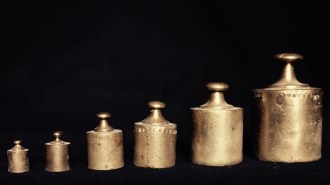Search Results
Write a scientific question based in history
In this quick activity, students will write a scientific question to learn more about a historical artifact.
Learning Outcomes: Asking scientific questions
Mix concrete like a Roman
Students will answer questions about the online Science News article “These chemists cracked the code to long-lasting Roman concrete,” which explains the process scientists used to re-create the Romans’ superb building material. A version of the article, “Chemists Crack the Code to Ancient Roman Concrete,” appears in the February 11, 2023 issue of Science News.
Lake scavenger hunt
Lakes can vary in color based on levels of sediment, organic matter and algae. Sometimes though, a lake will stand out – not matching the other lakes in an area. Look for these anomalies by participating in a virtual lake scavenger hunt, and help figure out why these lakes don’t fit in! In this activity, students will learn how climate change influences lake color and will investigate lakes with irregular colors that have been impacted by natural or human-made forces.

The Road to Net-Zero
Human activities pump a lot of greenhouse gases into the atmosphere, and those emissions are driving climate change. In this guide, students will review greenhouse gases and their sources and learn about ways to reduce emissions.
How to make the future climate-friendly
Students will answer questions about the online Science News article “It’s possible to reach net-zero carbon emissions. Here’s how,” which explores various solutions to decrease greenhouse gas emissions. A version of the article, “The road to net-zero,” appears in the January 28, 2023 issue of Science News.
Diagram the way to net-zero greenhouse gas emissions
Students will review, discuss and diagram atmospheric greenhouse gases and their impact on Earth. Then students will analyze a graph to begin thinking about what it will take to achieve net-zero emissions. Learning Outcomes: Reviewing greenhouses gases and their impact on Earth, diagramming human impact, understanding the idea of net-zero emissions.

The Metric System Has Gained New Prefixes
In this guide, students will learn about new measurement prefixes, work with those prefixes in metric conversions and create their own units of measure.
Create your own unit of measure
In this quick activity, students will create their own unit of length to measure something in the classroom and use principles of dimensional analysis to convert their measurement to a partner’s unit. Learning Outcomes: Units of measurement, unit conversion.
New prefixes for the metric system
Students will answer questions about a Science News article that explores new prefixes for the metric system. A version of the article, “The metric system gains new prefixes,” appears in the January 14, 2023 issue of Science News.
Measuring up with metric prefixes
Students will review prefixes and their meanings, learn about the metric system’s newest prefixes and apply the definitions in metric conversions. Learning Outcomes: Proportion and scale, measurement and dimensional analysis, a deeper understanding of the metric prefixes.

Human Population Hits a Milestone
The world population has reached 8 billion people, according to the United Nations. In this guide, students will learn about how the human population has grown over time and how it is projected to grow in the future, then analyze a graph of world population data. In a quick activity, students will think about how a growing human population might impact various industries and how changes at the national or international level might help those industries support a larger population.
Preparing for population growth
In this quick activity, students will brainstorm the effects of population growth on industries such as agriculture and medicine, then will work collaboratively to come up with changes at the national or international level that will help those industries support the growing population.